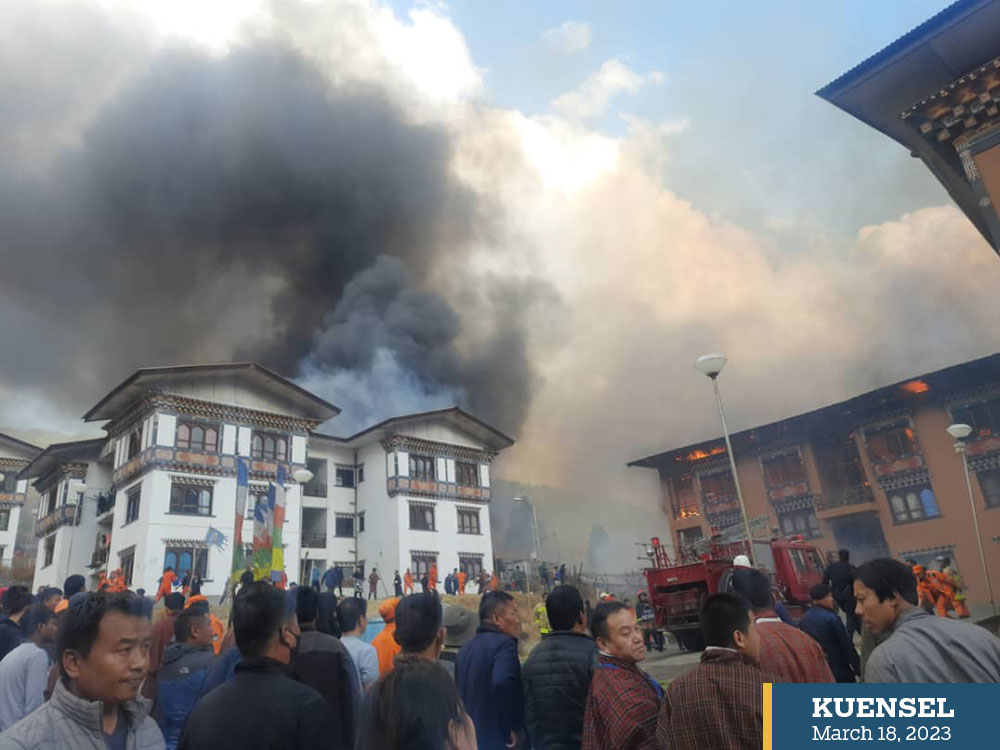Firefighting agencies suffer from lack of fund and resources
Choki Wangmo
Within three months, Thimphu recorded the highest number of fire outbreaks. In the 14 incidents so far, some lives were lost. Thimphu Thromde is home to over 100,000 people, some living in squatter settlements.
The official investigations of fire cases have so far been either inconclusive or incomplete. Faulty electric lines or leakage of LPG gas cylinders continue to be the chief suspects. But the people have also begun to question fire safety risks and the preparedness.
The agencies concerned—fire division of the police and the Department of Disaster Management (DDM)—say that there is no proper coordination plans, human resource allocation, and firefighting equipment.
Police fire division
Thimphu has four fire outstations with 1,500L tankers each at Tashichhodzong, Semtokha Dzong, Motithang, and Dechencholing. Out of the 48 firefighting vehicles with a capacity of 5,000L-10,000L in the country, Thimphu has only six. In Thimphu, the division is managing fire outbreak cases with only 68 trained firefighters.
The Officer Commanding of Fire Division Major Tshering Penjor said that the water tankers are always filled and kept ready throughout the year but the lack of water reservoirs or sources and equipment in various locations is impeding the firefighting efforts.
For example, if there is a fire outbreak in Khasadrapchu, without access to proper water source, the tankers will have to be refilled from the reservoir at the fire station in Changzamtok.
“Every disaster draws huge number of crowds, creating traffic congestion for firefighters. It has a major impact on our response team,” the Tshering Penjor said.
He said that in case the firefighting vehicles break down, it is difficult to procure spare parts as most of the vehicles are out of market in other countries. Each tanker costs Nu 4 million.
The division has proposed for more firefighting equipment to the government.
Deparment of Disaster Management
Chief programme officer of the Risk Prevention and Reduction Division, Thinley Norbu, said that the responders are not adequately skilled to tackle the disasters. “Virtual training is not useful as participants need hands-on training with equipment. They need expertise and skills from the countries with best practices. But we do not have enough funding.”
The lack of coordination among the agencies concerned is also one of the major causes of failure in responding to fire incidents.
Thinley Norbu said that instead of implementing security measures, people during such disasters are seen saving their belongings, which increases the risk to their lives and also creates congestion for first responders.
The country’s disaster management is carried out in three levels—national, dzongkhag, and gewog—with more focus on preventative measures.
Local government leaders have to monitor wiring systems and organise advocacy and awareness programmes in the gewogs.
However, enforcement of regulations, he said, is very poor. “For instance, there should be a buffer zone between buildings for safety, but no one seems to care about such important requirements.”
Without proper facilities, most of the faulty and risky situations are found in temporary huts. There are number of squatter settlements in Thimphu. The traditional houses and temporary shelters are vulnerable to fire accidents as the construction materials used add as fuel. The use of substandard electric materials and faulty wiring systems are major causes of house fires in the country.
Strategic Environmental Assessment for the Thimphu Structure Plan 2018 recognised fire hazards in Thimphu as one of the pressing issues. The thromde is vulnerable to hazards due to location, absence of proper site selection for infrastructure development, lack of hazard zonation maps, weak preparedness, response and relief care.
It recommended that the thromde determine its vulnerability to fire hazards and implement mitigation measures. “It will be important to ensure equal distribution of fire hydrants in localities across Thimphu Thromde at the earliest.”
The fire hydrant near the Royal Insurance Corporation of Bhutan Limited office is empty and the one near Druk Punjab National Bank along Norzin Lam is filled with soil. There are no fire hydrants in the core city.
Bhutanese buildings do not have fire sirens and sprinkler systems.
Bhutan Power Corporation
BPC’s chief executive officer, Sonam Tobjey, said that short circuits are caused by poor quality of wiring, damaged wiring such as deterioration of wire insulation, electrical wires exposure to water, loose connections and overuse of socket outlets and overloading of the system.
“There are risks of electric shocks and fire outbreaks from poor quality of wiring,” he said.
Regular maintenance, circuit protection devices, avoiding circuit overload, and replacing faulty wirings, among others, are some of the risk reduction measures, Sonam Tobjey said.
Way forward
Fire is one of the major hazards in the country. Last year, police recorded 77 house fire incidents in the country, of which 17 houses were in Thimphu.
Within three months this year, the country has seen 56 fire incidents.
Police say that awareness and advocacy start from home. The children should be taught how to take care of fire, for instance, how to put off the electrical appliances when not in use.
Police provide advisory services on fire to schools, monasteries, construction sites, and tourist hotels, but only upon request from the individuals and offices concerned.
“Bhutanese are aware of fire risks but we are careless. Tackling fire hazards is a shared responsibility,” said fire SP Colonel Tshering Dukpa. “The focus should be on prevention.”
Thinley Norbu said that prevention starts with non-structural hazard mitigation measures. For example, keeping a bucket of water near a butter lamp offering. “Time is crucial in risk reduction.”
The challenges are expected to heighten as Thimphu’s population is projected to increase to 263,152 people in the next three decades.


